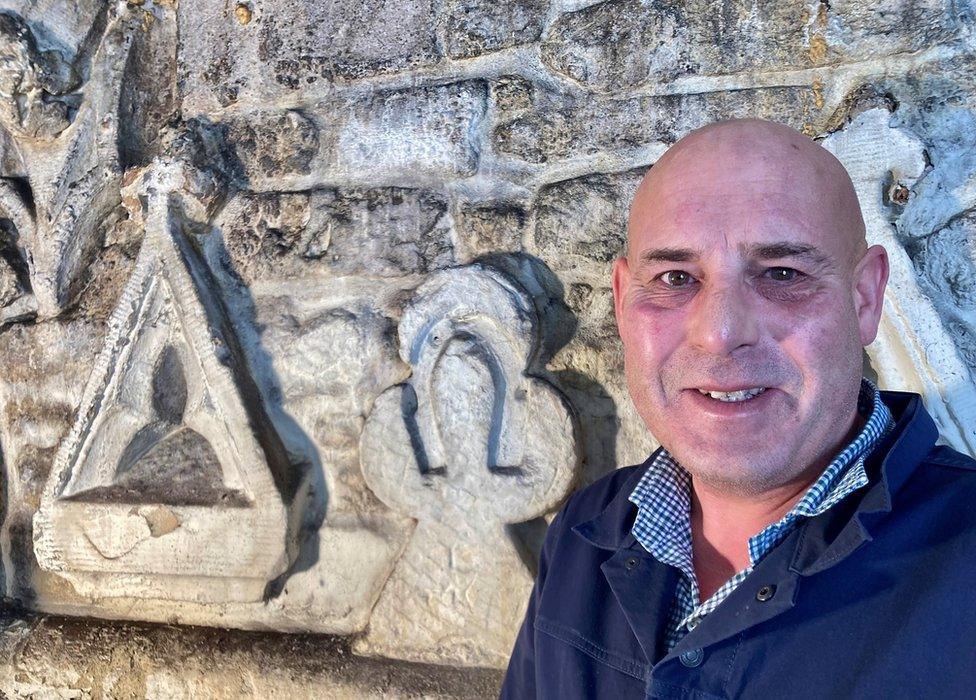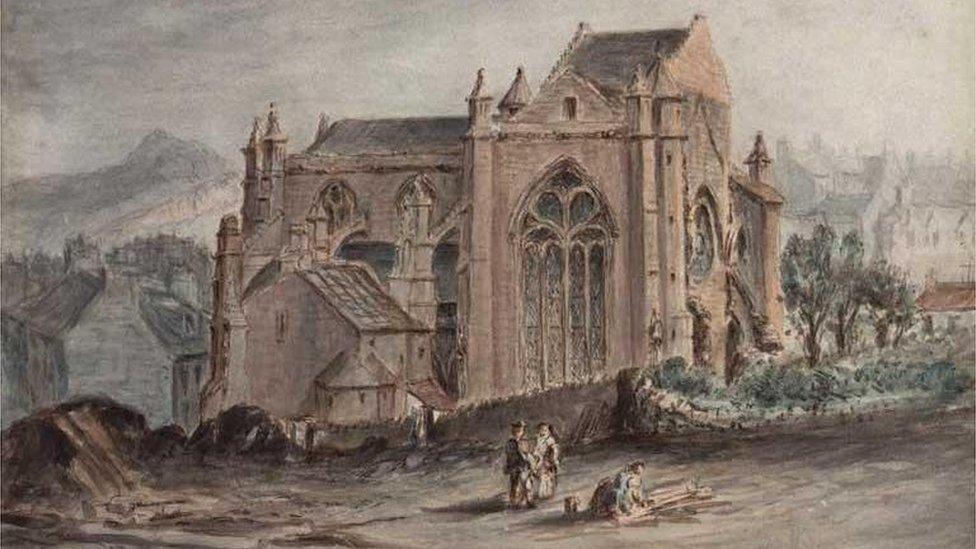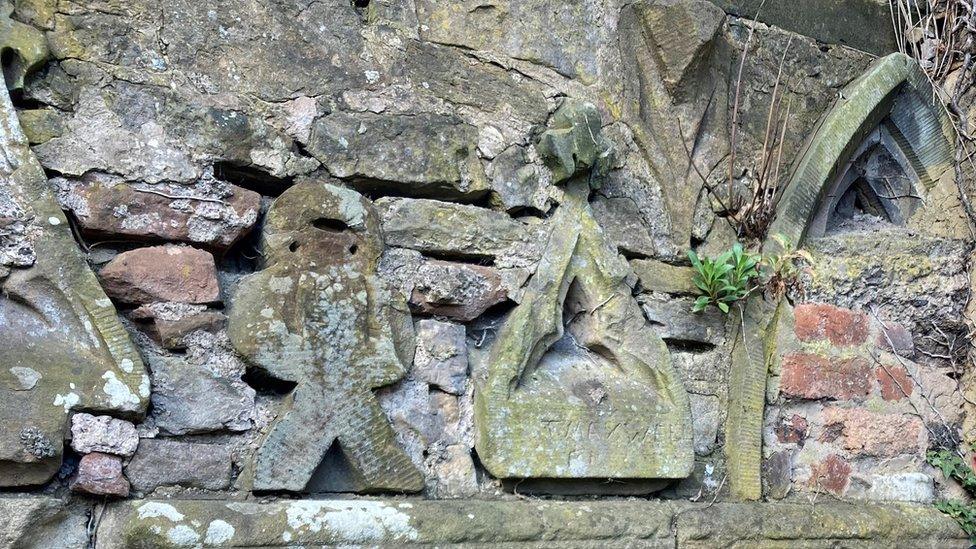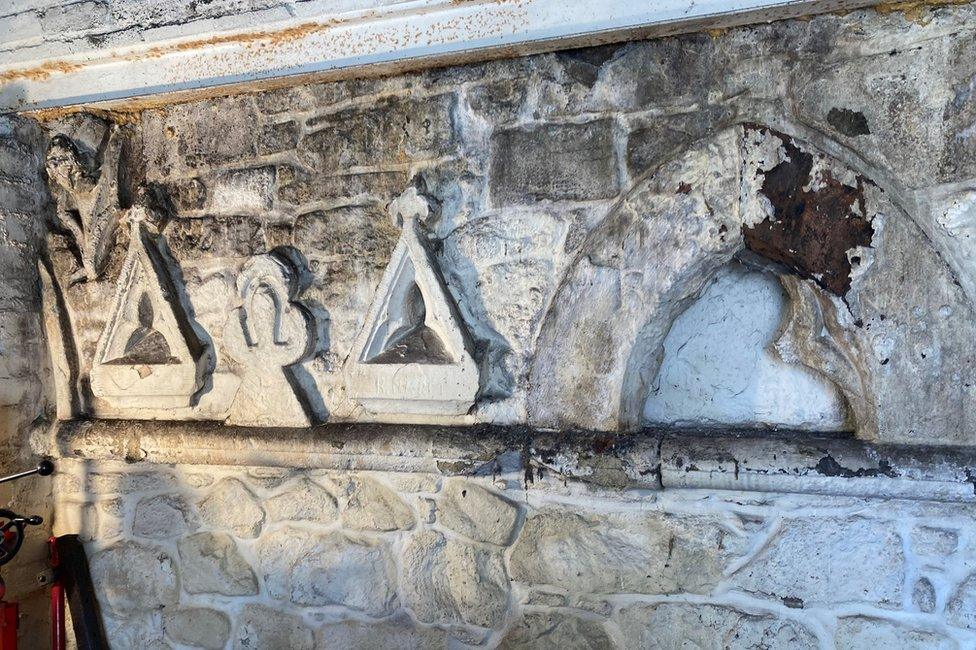Mystery carvings came from dismantled royal church
- Published

Three of the carvings in this picture are thought to have come from the Holy Trinity - the exception is the one with the upside down horseshoe
For decades, Daren Frankish wanted to know the story of the ancient stone carvings on the wall of his Edinburgh workshop.
The lawnmower shop owner tried looking for information in books and consulted people connected to religious orders without any clues.
But after he contacted BBC Scotland, we spoke to a range of experts who have been able to solve the mystery.
Dr Lizzie Swarbrick, an expert in medieval Scottish art and architecture, said many of the carvings came from the Collegiate Church of the Holy Trinity in Edinburgh.
It was regarded as one of the finest buildings from late medieval Scotland but was dismantled to make way for Waverley railway station in 1848.
The church was later rebuilt elsewhere but many of the stones "went missing" while arguments raged about where.

How the Collegiate Church of the Holy Trinity in Edinburgh looked before it was dismantled and rebuilt nearby
The church was built for Queen Mary of Guelders between 1460 and 1463 to provide her resting place, and in memory of her husband, King James II who had been killed by an exploding cannon when inspecting his new artillery at Roxburgh Castle.
When the church was dismantled to make way for Edinburgh's main railway station all the stones were numbered and stored in a huge pile on nearby Calton Hill.
It took more than 20 years for disputes between church leaders and council officials over where the church should be rebuilt to be resolved.
By the time reconstruction of the church began in 1872, only a third of the stones remained. It was only possible to complete the apse and choir.
Dr Swarbrick was able to confirm that some of the stones ended up in the wall of what is now Mr Frankish's workshop in the city's Springvalley Gardens.

There are further carvings outside the workshop - the carving that looks like a man is thought to be a back-to-front finial - the stone at the gable end of a building. The "eye holes" would be where a metal or brass plate was attached
The medieval expert said: "When I saw photographs of these carvings it set my heart racing because it is another piece of the puzzle from the Church of the Holy Trinity.
"It is really cool to find them.
"The Holy Trinity is one of the finest buildings from late medieval Scotland, so to now know there are chunks of it in this wall is lovely and very exciting."
Dr Swarbrick said the church once stood on the spot now occupied by platform one of Edinburgh Waverley railway station.
It was rebuilt in Chalmers Close on the newly-formed Jeffrey Street, overlooking the original site.
She said the building had various uses over the years but was seldom open to the public.
"Many people, even Edinburgh residents, don't realise that Scotland's finest late medieval church, the foundation of a Queen, lies just down an alley off the Royal Mile."

The experts said the flower carving at the top left of the carvings inside the shop, the two trefoils (gable ends) and the top of the door/window on the far right are from the Holy Trinity
The church was built of local sandstone from a nearby quarry and was created in the cosmopolitan Scottish late Gothic style.
Water was discharged from the roof via gargoyles which were said to crouch in agony under the weight of their load.
Dr Swarbrick said some of the decorations inside the church were quite unusual.
Mr Frankish, 52, who owns Lawnmower Services, said he was happy to show people the carvings at his shop.
He said: "I've spent 35 years trying to find out what these carvings are and where they are from.
"So to finally find out is very exciting. To think they are more than 550 years old has taken my breath away.
"The story about the church where they came from is so interesting and to hear about the royal connection is just brilliant.
"I'm very relieved to finally discover what they are."

A drawing of the north aisle inside the Holy Trinity in 1852 shows the carved stone shapes above the doors and windows
A spokesman for Historic Environment Scotland said fragments could have been removed from the stones of Holy Trinity in the late 19th or early 20th Century.
Adam Cumming, fellow of the Society of Antiquaries of Scotland specialising in medieval church archaeology, said the workshop wall had been assembled from recycled stone.
"People have picked up pretty bits from Calton Hill where the pieces of the Holy Trinity were stored.
"It is the reason why the apse (in the rebuilt church) is smaller."
It is thought that the carvings which came from Holy Trinity include a flower, tracery, pinnacles, and a gable end.
Another carving of an upside down horseshoe is thought to be from a later period.
Historian Eric Melvin, who lives in the Morningside area, said there were two possible local sources for the stone which had not come from the Holy Trinity.
These were St Roques Chapel, which stood in the grounds of the nearby Astley Ainslie Hospital, or the Convent of St Catherine of Sienna, at St Catherine's Place.
He said they were both destroyed in 1559 by an Edinburgh mob.